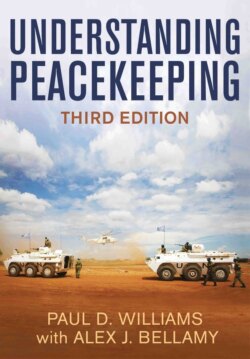Читать книгу Understanding Peacekeeping - Alex J. Bellamy - Страница 15
Enduring themes
ОглавлениеThese contemporary political developments do not signal the end of peace operations. Indeed, the relative spike in armed conflicts worldwide since 2011 suggests a continued demand for peace operations to help manage their endings and aftermaths. Moreover, near record numbers of peacekeepers remain deployed across some of the world’s most protracted war zones. As we seek to explain and understand these dynamics, it is worth briefly highlighting four enduring themes that continue to shape contemporary peace operations and thus lie at the heart of this book.
First is the ongoing and inherently political struggle between proponents of the more limited Westphalian conception of peace operations and the more ambitious agenda of those who understand them in post-Westphalian terms. It is important to recall, however, that even the post-Westphalian approach has some important practical limits, notably most of its advocates suggest that peace operations should deploy only with the consent of the de jure host government except in the rarest of circumstances.
A related theme is the struggle to conceptualize and respond effectively to the changing character of armed conflict. In particular, the design of peace operations should be based on a sophisticated and accurate understanding of key concepts related to armed conflict, notably globalization, stabilization, counter-insurgency, counter-terrorism and mass atrocities. Ultimately, peace operations will remain little more than band-aids or exercises in damage limitation unless they are based on an accurate theory of change for how their personnel and other international instruments of conflict resolution can turn war-torn territories into zones of stable peace.
A third enduring theme is the struggle to close the often very large gaps between the means and ends of peace operations. The subsequent capability gaps have assumed several forms, including not authorizing sufficiently large operations in order to save money; failing to deploy the authorized number of peacekeepers into the field; and failing to generate the appropriate type(s) of capabilities required to implement the mission’s mandate. It is therefore quite common for there to be large gaps between the theory and practice of peace operations.
Finally, as we will discuss throughout this book, it is important to remember that the United Nations does not have a monopoly on peacekeeping. Numerous multilateral organizations and states have conducted peace operations. An important part of understanding peacekeeping is therefore understanding the partnerships that have emerged and the ongoing struggle to professionalize and institutionalize the multiple bureaucracies of peace operations. This is not to suggest that peace operations can or should ever become formulaic. They are, by definition, responses to mostly unforeseen crises. But there is value to maintaining a degree of core bureaucratic and institutional predictability and capacity, as long as those mechanisms can remain flexible in responding to unique crises, work with partners, and adapt when circumstances change. This is something with which every organization and actor engaged in peace operations has to struggle.
